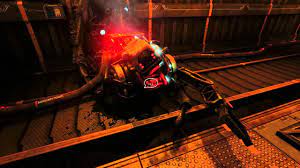Usually, when we think of machines, electronics, or the like, we think of them as non-living and even further as non-human. They run on programs and algorithms and some of them give us data, all of which we would like to think of as objective. Behind all of this, it’s hard to see that humans are the architects of the virtual space and ultimately decide how much or how little control we have in that sphere. Human bias is programmed into the machine.
A good real-world example of that is Facebook, which has an algorithm rife with reflections of social issues and biases, including but not limited to racism and sexism (Heilweil 2020). A fictional example that is more aligned with Soma—that I immediately thought of when playing the game—is an episode of Doctor Who, “The Girl in the Fireplace.” In this episode, (spoilers, I suppose) the Doctor and companions find themselves on an abandoned and broken down ship that has been programmed with the command to repair the ship at any cost…and so it resorts to harvesting the crew for parts. While lacking the insidiousness and reality of the Facebook example, it illustrates the way in which machines are imperfect extensions of ourselves, giving us the results we asked for if not quite the ones we wanted.
The line between human consciousness and the machine are blurred even further in Soma, where it is revealed that the crew have had their minds uploaded into machines by the Warden Unit, which was programmed to preserve humanity. It has somewhat succeeded in this, but in the process has created versions of the crew that are stripped of their autonomy and sanity. Where the programmers sought to have the machine aid in humanity’s “survival,” their human assumptions ultimately led them to fail to create an algorithm that could successfully complete this task. “Preservation” is undesirable because it has failed to adequately salvage much of the “humanness” that the crew could have retained.
The player experience further emphasizes the uncomfortable duality of the connection between human and machine as the player interacts with the game through Simon’s character. Being a video game character, Simon is already a synthetic human with a controlled field of choices, creating an immediate barrier between his experience and the player’s experience. Simon also faces several non-choices in the game to “kill” human consciousnesses, which have theoretically already been placed into the ARK, in dilapidated robots. It raises the unsettling question of if they are really dying if they still have versions of themselves saved somewhere or if they are already dead, having lost their human form and agency. Simon is also twice forced to sacrifice a version of himself. The first time, the player can choose to kill the version that will not persist with the gameplay, effectively marking it as an obsolete human consciousness, but the second time, the player remains with the version of his consciousness that is trapped in a form that cannot die. Simon has, in a way, doubly succeeded in his mission; there is an immortal version of himself in the ARK and another immortal version of himself trapped in the abyss. The player is forced to stay with Simon as he experiences the horror of the entanglement of human and machine; both his remaining human consciousness and his machine body have aided in his doom.

